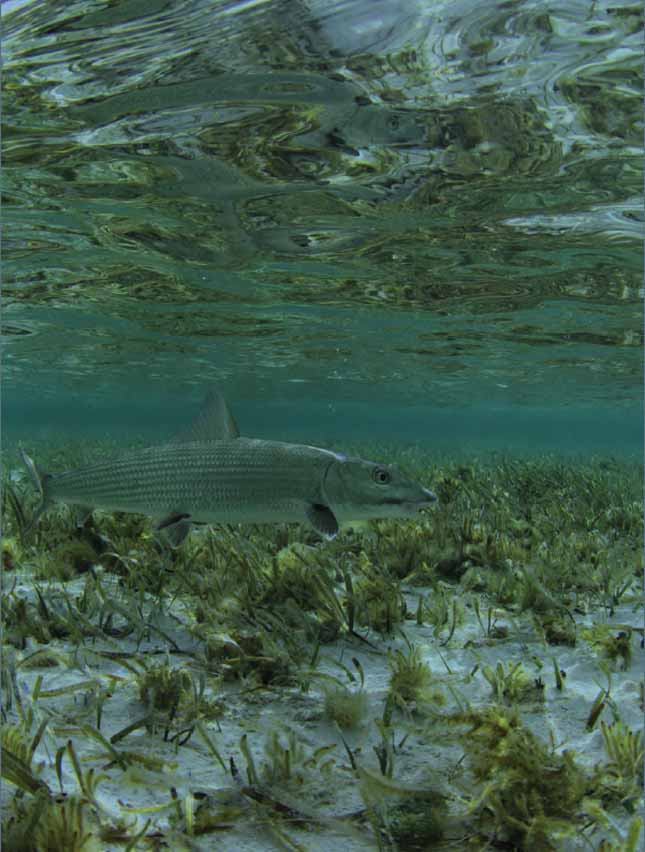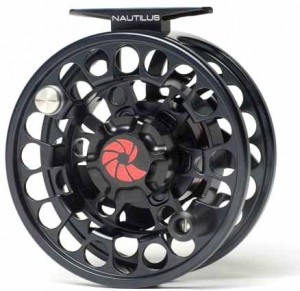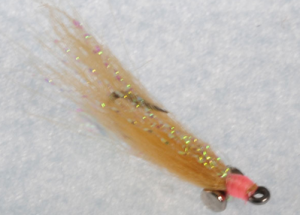
“Bonefish Greens” – photo by Adrian Gray. To visit Adrian’s website click here
By Skip Clement.
[dropcap]Y[/dropcap]ou can do-it-yourself – catch a few bones on a DIY basis in The Bahamas, but realistically it’s pretty tough to get a good ROI and it’s very physically demanding. To be successful, you’ll have to be a good angler (cast at least 60-feet accurately in one or two false casts), have experience fishing for bones and you’ve got to know how to feed the fish. The flies you bring are extremely important (more on that later). It’s also important that you know as much about the area you intend to fish as possible. To better perform, know the tides and work hard when you arrive to find out where the best places are to fish; places you can reach by rental car, scooter, golf cart (Harbour Island – Eluethera) by foot or taxi each day. There isn’t a lot written about where to DIY fish in The Bahamas, and that’s a good thing. However, there is a book titled The Bahamas Fly Fishing Guide, but like most travel guide books they date quickly. My recently purchased “updated” copy has a publishing date of 2005, which may or may not be “current.” The co-authors Stephen and Kim Vletas cover the islands like a blanket and they’re very savvy fly anglers so there’s plenty of meat inside this softcover tome. Our staff recommends the book.
The toughest thing gets barely mentioned
Most of the time during your DIY day’s outing, you’re going to have to see the bones in gin-clear, skinny water over grass beds, sand bottoms, soft marl-like bottoms, mixed bottoms and coral out-cropping bottoms. The flanks of a bonefish are silver mirrors of any bottom they swim over. Unless they’re tailing, you’re looking for a shadow or wake (in calm waters) that’s at least 45-feet or more away and you’ve only got a perspective of 5-feet if you’re standing in a foot of water and your 6-feet tall. You’re not getting the perspective from a casting platform on a skiff or the advantage of an eagle-eyed guide telling you 50-feet at 12 o’clock from a poling platform. Good luck on the first day when your novice eyes can’t distinguish much of anything other than sameness and horrific glare, even if the sun is at a perfect angle and the tide is right. Then there’s the fact that if it’s windy, which it is almost everyday in the winter – you aren’t going to see much of anything that resembles a shadow and if it’s overcast, not much of a chance there either. Are you thrilled yet?
If you’re determined
Here’s a few useful tips. For all practical purposes, a 9-weight is the best bet rod (bring a back up). It can corral bigger fish and it makes the landing and releasing of a bonefish quicker than with a 7-weight or 8-weight – reducing the chances of predation or death by exhaustion. You’ll also appreciate a 9-weight when the inevitable wind kicks up late morning or when the bones are more interested in lead-eye, sinking flies.
A good quality reel is a must (hold at least 150-yards of 20-pound test backing), but an $800 one isn’t necessary. A cheapo made in China reel shouldn’t be considered. Think drag quality and you’ll come around to Made in the U. S. A. (bring a back up). The best fly line would be WF floating with a clear tip. For quick loading, over-lining by one weight to a 10-weight (if you’re using a 9-weight) helps some anglers perform better – I’m one of them. Better made fly rods are purposely crafted to handle two line weights. That said, a slow flexing rod doesn’t cast well when over-lined.
The art of bonefishing
A stripping basket is just too cumbersome to carry around – in the way actually. Instead, let out about 50-feet of line so that it loops around behind you as you wade. Keep about 10-feet of line out of the tip-top and hold the fly just aft of the eye of the hook in your opposite hand.
The best way to scout the flats in a few inches of water is to stalk like a wading bird and in deeper water shuffle like grandpa so you don’t step on a sting ray. The new textured or dimpled fly lines have so much less surface tension (lotus effect) they should be considered, especially for this kind of fishing. For example, textured fly lines by Scientific Anglers® will allow you to pick up 60-feet of cast fly line and recast in one haul; not doable with smooth fly lines. Dimpled lines’ drawback is finger burn when sliding the line through your naked fingers (use a finger glove), and it does burn. I’ve never found it to be a deterrent or real inconvenience – if you can even call it that. Most sissy (ouch) complaints come from our white-collar trout cousins who even complain about the whistling sound the line makes going through the guides.
You see bones?
There are three distinct scenarios of bonefish on a flat: tailing, cruising or stopping only occasionally to feed. The longest lead is when they’re cruising (judging speed takes a little practice), which is generally in deeper water. Here, you’re guessing at a point of intercept with the depth that your fly swims in becoming “muy importante.” A bonefish is look-down feeder so a fly swimming 2-feet above it won’t be seen or eaten. With spot feeders, you can plunk your fly down in front of their assumed path, about a dozen or so feet from the current feeding coordinates. Bones that are tailing are aggressively feeding and you can plop your fly up close and personal, but if you spook one the shoal will empty faster than green grass through a goose. A better strategy is to cast your fly (crab pattern best) at around 8-feet or more away from tailing bones at the assumed intercept. Just let the fly sit until the school, or single, is almost on it, then twitch it like a crab ambulates. What is twitch? A few inches, not a long strip. A crab ambulates with pulses of movement, not swimmingly. In the case of a single or few “big” bones, drop your fly closer – don’t give it (or them) time to “think.”
During almost any “normal” day on a Bahamas flat the wind speed will change; calm at dawn to an increasingly stiffer breeze at around 10- or 11 o’clock in the morning and as sunset segues to darkness there’s a reverse of the morning progression. If a front is moving through in the winter, it could be very windy all day for a few days. The point here is that you’re going to have to change leaders: 12- to 14-feet or more when it’s windless, to 12-feet for a 10- or 12 knot wind and 9-feet or shorter with 17 knot winds or more. Keep checking your leader for wind knots and replace ASAP. Don’t be lazy! A good practice is to use loop to loop on your butt section and pre-tie all your leaders and keep them in individual packets on your person. It’s faster to do a complete replacement than to fuss with leader sections and multiple knots, especially when there’s animals all around. The worst mistake with knots is that they are not seated properly, the wrong knot (a blood knot joining greatly dissimilar line diameters) and not knowing the Albright or Non-Slip Loop.
Flies

Matched with a 9-weight, this Nautilus CCF 10 is versaitle. With an 8-weight line It holds 350 yards of 30-pound test backing and with an 11-weight, 200-yards, and with 20-pount test backing – far more.
Take a lot of time and care with regard to choosing or tying flies for a Bahamas Bonefish outing. On any given day a killer crab pattern tied on too big a hook can be unproductive and tomorrow the smaller fly that was a killer yesterday can be a dud – and so it goes with fly fishing. However, there are patterns that have stood the test of time and here’s what our Fly Tying Editor Don Reed, an expert angler, fly tyer and many times Bahamas visitor suggests for bonefish flies for the Bahamas. Don Reed said: “Here are my no fail, must have flies for DIY or anyone.” Pink, Pearl, and Tan Crazy Charlies size #4; Clouser Bonefish Flies in Pink, Tan, and Chartreuse size #4; Puff Flies in Pink and Tan size#4; Tan and Pink Gotchas size #2 or #4; Blind Charlies size #4; Blind Gotchas size #4; Silli-Legs Gotcha size #6; Raghead Crab Fly size #2 or #4.
Take it to the water
Polarized sun glasses with amber tint lens’ with side “windows” are best for fishing the flats (you’ll also want a retainer). Also: flats sneakers with neoprene “socks” (dive shop item – Simms has a 1-mil thick sock that’s excellent) and gravel guard to keep sand and coral chunks out, long spf rated pants, long sleeve – multi-pocketed and spf rated shirt, hook sharpener, buff for your neck – face, wide brimmed hat with dark colored under peak (glare), front and back fanny packs with at least two dozen flies (an aggressive caster will generally go through six or more a day), hook sharpener, line snipper, Swiss-like pocket knife, deet bug spray (oh yeah), hook removing pliers, sunscreen, pre-tied leaders and tippet spools, waterproof pocket camera, lens cloth and cleaning solution (for glasses and camera lens), small towel, rain jacket, sun gloves, bottled water (as much as you can carry) and anything quick energy that won’t melt to mush.
When there’s a breeze and you’re wet, you’re going to be tricked into believing you’re hydrated or not getting fried – be careful. Also, in the Bahamas and the Florida Keys, the sun rains down like a flame-thrower almost everyday. Make sure you’ve always got plenty of sunscreen on. If you’re of Middle Eastern, Mediterranean or African decent, but live in northern climes, you’re not exempt from severe sunburn or worse, heat stroke. Don’t be proud, be smart.
NOTE: Sunscreen and bug spray are as repugnant to fish as tobacco and petrochemical based products. Fish can smell them from afar. Before you head to the water, and in your room, plaster on the sunscreen and then thoroughly wash your hands. Do the same with bug spray. When you reapply, use the saltwater your standing in to remove the lotion from your hands and then use the towel you brought to finish the job. Never touch the leader, fly line or fly with sunscreen or Deet soaked hands.
Here’s some sage advice
As soon as you arrive, contact a guide (see sidebar). Tell him upfront about your intentions. Ask him if he’ll wade guide for at least a day or two. If he’s OK with your proposal he might take you to some really good spots. If you can round up a kayak or rent a small boat, you’ll be able to access a lot more fisheries – assuming you know where to go. Bring a GPS and map.
If all of the above sounds like too much work and the high probability of a low ROI doesn’t thrill you, then call Frontiers‘ Joe Codd or contact your preferred outdoor travel agency and get saddled up right for a better ROI on your next Bahamian angling adventure.
Worth mentioning
There’s a must read book on bone fishing by Chico Fernandez, Fly-Fishing for Bonefish. There’s a whole section on habitat diet and more by angler, author and Ph.D. Dr. Aaron Adams (Bonefish and Tarpon Trust and Mote Marine). This bonefish bible has it all. You’ll never need to ask another question about the The Flats Ghost.
[information]
SIDEBAR: Probably the best or easiest DIY bonefishing islands in The Bahamas are Cat Island, Eleuthera, Exuma, Long Island and to some extent Grand Bahama. Bimini has one big flat, Abaco is doable and Andros’s Fresh Creek is very popular with DIY folks, but it can be as crowded as the Juniata River in Pennsylvania on opening day of trout season.
Your chances of encountering permit or tarpon are slim to none.
Guides
Everyone on these small out-islands (Cat Island, Eleuthera, Exuma, Long Island) knows who the bonefish guides are, it’s no secret. Also, the proprietor at your accommodation will definitely know who the guides are, have their phone numbers handy and be able to provide personal info about them. Guides in The Bahamas generally charge anywhere for $300 to 450 a day. Offshore costs more.
Transportation
Getting there and getting around: www.westernairbahamas.com/, www.bahamasair.com/ and www.gosunair.com/. There are also ferries and mailboats www.bahamasferries.com. The most affordable method of transportation between all fourteen islands of The Bahamas, if not the most dependable, is by mail boat. Mail boats depart on a typically regular schedule, but can be canceled or face an itinerary change at a moments notice (bahamas-guide.info/getting.around/ferries.and.boats/mail.boats/). On island transportation rentals can be boat, kayak, bicycle, car or golf cart. Taxi service is reliable throughout The Bahamas.
Population
Population data Bahamas, census 2010: Acklins (pop. 560), Abaco (pop. 16,692), Andros (pop. 7,386), Berry Islands (pop. 798), Bimini (pop. 2008), Cat Island (pop. 1,503), Crooked Island (pop. 323), Eleuthera (pop. 9,363), Grand Bahama (pop. 51,756), Inagua (pop. 911), Long Island (pop. 596), Mayaguana (pop. 271), New Providence (pop. 248,948), Ragged (pop. 70), Rum Cay (pop. 99), San Salvador (pop. 930).
[/information]











Great article , I wish it was around when I went to Cat Island in March .